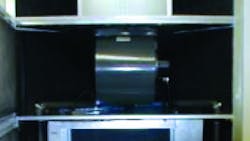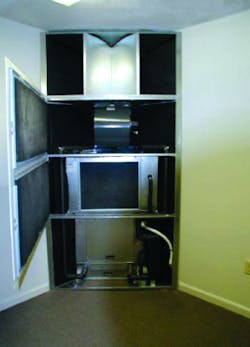Geothermal Systems for Commercial Facilities
When I started my career 17 years ago, only a few geothermal-unit configurations were available, and those met most industry needs. With the inception of the LEED (Leadership in Energy and Environmental Design) green-building rating program and stricter ANSI/ASHRAE/IES Standard 90.1, Energy Standard for Buildings Except Low-Rise Residential Buildings, and ANSI/ASHRAE Standard 62.1, Ventilation for Acceptable Indoor Air Quality, requirements, the geothermal industry has evolved. This article provides an overview of the wide array of geothermal options available to design engineers and commercial-building owners seeking to sharply reduce operating costs.
Geothermal Refrigeration Cycle
A geothermal system is very similar to a traditional HVAC system. The key difference is that a geothermal system transfers heat via the ground, which stays at a constant temperature year-round, while a traditional HVAC system transfers heat via the air, the temperature and humidity of which vary greatly, according to the weather.
The refrigeration cycle of a geothermal system involves five basic components:
• Compressor.
• Water coil.
• Air coil.
• Thermostatic expansion valve.
• Reversing valve.
A system operates in cooling or heating mode, depending on the position of the reversing valve. In cooling mode, the compressor pumps refrigerant to a high temperature and pressure. The refrigerant then is sent through the reversing valve (set in cooling mode), from which it travels to the water coil. The water coil acts as the condenser in a traditional heat pump. The water coil cools the refrigerant and brings it to a saturated state. The refrigerant then enters the thermostatic expansion valve, where it is flashed, producing a combination of liquid and vapor. The refrigerant mixture then enters the air coil, where it is taken to its lowest state of pressure and temperature. At this point, the refrigerant enters the compressor, where the cycle starts over. In heating mode, the reversing valve is switched, effectively reversing the refrigeration cycle.
Benefits of Geothermal Systems
Unlike most conventional equipment, geothermal equipment is rated based on energy-efficiency ratio (EER), the ratio of cooling capacity in British thermal units per hour to total electrical input in watts under Air-Conditioning, Heating, and Refrigeration Institute-specified test conditions. Smaller refrigerant-based equipment is rated based on seasonal energy-efficiency ratio (SEER). An article¹ in Outside the Loop, a newsletter for geothermal-heat-pump designers and installers, makes a compelling argument for comparing these values, a task made difficult by the fact the ratio between EER and SEER varies by location in the United States.
Standard 90.1 establishes baselines for different types of systems. The 2010 version has a couple of different methods of computing energy savings above the baselines. Standard 90.1 acknowledges energy efficiency and savings are greater with geothermal systems because the baseline system has a higher—in most cases, by 25 percent—efficiency rating than other types of systems. Geothermal meets all LEED requirements for refrigerant use, including zero ozone depletion, but really shines in energy savings.
Geothermal Offerings
There are many geothermal-system types, each with multiple options. The intent of this article is not to point out every type and option available, but to review the highlights of both traditional and non-traditional configurations.
Unit tonnage. Standard geothermal-heat-pump capacity is in the 1-to-6-ton range. A few manufacturers have expanded their product offerings to the 6-to-25-ton range and beyond. For small spaces, some of these same companies offer units in fractional tonnages below 1 ton.
Orientation. The most common orientations of geothermal systems are horizontal and vertical. With a horizontal unit, fan discharge out of the top, sides, or end is possible. Return air and outside air are adjustable as well. Unit size is dictated by tonnage because the unit housing encloses not only the cooling/heating coil and fan, but the water coil, compressors, valves, and more.
Some manufacturers are willing to rearrange the components in a system to accommodate height, length, or width requirements. This customization may come at a premium and should be considered only when all other options fail. The fan and air coil could be separated from the compressor and placed in separate boxes, which would allow the compressor to be located in a different room, with refrigerant lines routed back to the air coil. This would require the manufacturing engineer to calculate how far away the sections could be placed and would slightly diminish the performance of the unit.
Applications. Extensive geothermal system and option configurations are available to commercial-facility owners. The systems most commonly in use today are:
• Horizontal and vertical. The main advantage of horizontal and vertical units—and the likely reason they are the most preferred—is their location inside of a building, which greatly slows the degradation of the housing and components, as they are not exposed to extreme weather.
• Rooftop. Rooftop systems come in many varieties. Without the limitation of walls, they typically are a little longer than most horizontal units. The unit housing is made of a heavier-gauge sheet metal to help it withstand the weather. Typically, rooftop equipment is used only when interior floor space is at a premium. The main difference between geothermal rooftop equipment and standard commercial rooftop equipment is the presence of a water coil, rather than a condensing coil with fans drawing air across it, inside. A benefit of rooftop equipment is that some manufacturers offer additional configurations, such as the ability to temper outside air before it mixes with return air.
• Vertical stacked. Vertical stacked equipment is used in facilities in which similar rooms are stacked on top of each other, such as hotels and hospitals. The configuration of the equipment usually dictates the units span from floor to ceiling (with blank-off panels) and contain all necessary geothermal components in a confined, efficient space. Usually, an outside-air duct is mounted to the equipment, and pipes that can penetrate from floor to floor in a vertical orientation run behind the unit.
• Water to water. Water-to-water systems have many practical uses, including radiant floor heating, pool heating, and even chiller retrofitting. Rather than have an air coil and fan, these systems have another heat exchanger in the refrigeration loop; heat is transferred from one water stream to another. A secondary set of pumps is required on the load side of the unit to circulate water according to demand. Because water is a great medium for heat transfer, this type of system has excellent efficiency ratings on the scale of 4 COP.
• Corner units. Corners often are dead space in a room, which makes them ideal locations for heating and cooling equipment. With a corner unit, piping usually is routed overhead and dropped inside. If the unit sits on an outside wall, a duct for outside air can be attached easily.
• Dedicated outdoor-air system (DOAS). Some manufacturers’ standard DOAS equipment has a water coil for heat exchange, while others’ is fully customizable. Usually, a dedicated-outdoor-air geothermal system includes supply-, exhaust-, return-, and outside-air openings with either a plate-and-frame heat exchanger between airflow paths or a desiccant wheel built into the system. Such a system can be configured to have single or multiple supply and exhaust fans.
System options. For each system, there are options, including:
• Electric strip heat. Also known as electric resistance heat, this option involves the addition of an electric resistance coil inside of a unit. Contrary to popular belief, adding strip heat does not increase air temperature while a unit is running. There was a time when geothermal systems needed this type of heating to produce enough heat for a given space, but not anymore. As a general practice, it should be added only in the case of system failure.
• Ultraviolet (UV) lighting. UV lights clean air streams by killing certain organic particulates as they pass by. UV lights can be field- or factory-mounted.
• Desuperheater. Many manufacturers have an option for heating potable water involving the factory installation of a heat exchanger inside of a unit. This allows the unit to transfer heat to water during summer and allows a small amount of heat from the compressor to be transferred during winter. During summer especially, water is able to be heated at little or no cost, depending on the domestic-water-heating load. Some manufacturers claim their systems can run in desuperheater mode only, which essentially bypasses the air stream and allows water-to-water operation. This allows hot water to be produced very efficiently, with an equivalent rating of approximately 3.5 COP.
• Two stage. In most parts of the country, part-load conditions occur for the vast majority of equipment runtime. Two-stage (usually, full load and half-load) compressors allow optimum performance at part load. To put the energy efficiency between full-load and part-load conditions into perspective, a geothermal system might have an EER of 14 at full load and upward of 26 at part load. In other words, it is almost twice as efficient at part-load conditions, which represent the majority of its operating life.
• Permanent-split-capacitor (PSC) or electronically commutated motors (ECMs). Several years ago, when fan technology was in its infancy, most geothermal units were equipped with PSC motors. Some manufacturers still equip systems with these types of motors, but most have changed to variable-speed ECMs. ECMs provide better efficiency than other types of motors and can be programmed with set speeds so that, under part-load conditions, the speed of a fan will be varied simply by different conductors to the fan being energized. This avoids the need for a variable-frequency drive.
• Controls. When it comes to geothermal systems, different levels of control are available, from a barebones system that controls only the unit to damper control to add-ons, such as the desuperheater, to the ability to connect to a building automation system.
Common Concerns and Myths
The cost of geothermal. Most owners installing geothermal systems are concerned less with upfront costs than they are with energy savings and simple payback period. Payback on a typical geothermal system can be as low as two years, depending on the upfront costs and the systems being compared. Other considerations affecting savings and payback include:
• Air handlers in the building. Should they be combined into a central unit or split into smaller units?
• Ductwork and piping lengths. More localized air handlers will reduce ductwork costs and fan energy, but may increase piping costs.
• Associated equipment costs. Multiple geothermal units may increase upfront cost because of more equipment. They also may increase the costs of localized pumping, fans, maintenance, and more.
• Rebates. Creativity helps to reduce initial costs of a geothermal system and realize savings much sooner. For example, some utility companies offer rebate programs, and some will finance a portion of upfront costs, allowing payments to be made over time. Visit www.Dsireusa.org for available rebates and savings by state. For a database of state incentives, visit http://bit.ly/DSIRE_incentives.
Maintenance and configuration. Some engineers resist learning how to design and implement geothermal systems, claiming the equipment is maintenance prone or will not work in certain applications. Maintenance is no more of an issue with a geothermal system than it is with a chiller/boiler system (excluding cooling-tower servicing) or with a common split system. Typically, the only items in a geothermal system requiring routine maintenance are pumps.
Some are concerned with the stability and proneness to failure of in-ground pipes. If fused together properly and installed per the manufacturer’s recommendations, in-ground geothermal-system pipes are warranted for at least 50 years.
Reference
1) The SEER of ground source heat pumps. (1999, Summer). Outside the Loop, p. 6. Retrieved from http://geoheat.oit.edu/otl/otl02-03.pdf
A senior mechanical engineer with Smith Seckman Reid Inc., Christopher Qualls, PE, CEM, has nearly two decades of experience with geothermal heating and cooling systems.
Did you find this article useful? Send comments and suggestions to Executive Editor Scott Arnold at [email protected].

